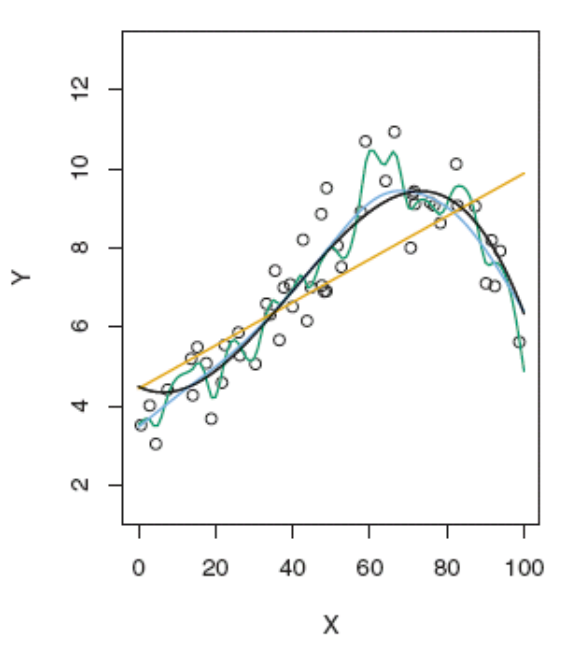Evaluating data-mining algorithms Science 03.08.2018
In this note, you will learn how to evaluate models built using data-mining techniques. The ultimate goal for any data analytics model is to perform well on future data. This objective could be achieved only if we build a model that is efficient and robust during the development stage.
While evaluating any model, the most important things we need to consider are as follows:
- Whether the model is over fitting or under fitting
- How well the model fits the future data or test data
Under fitting, also known as bias, is a scenario when the model doesn't even perform well on training data. This means that we fit a less robust model to the data. For example, say the data is distributed non-linearly and we are fitting the data with a linear model. From the following image, we see that data is non-linearly distributed. Assume that we have fitted a linear model (orange line). In this case, during the model building stage itself, the predictive power will be low.
Over fitting is a scenario when the model performs well on training data, but does really bad on test data. This scenario arises when the model memorizes the data pattern rather than learning from data. For example, say the data is distributed in a non-linear pattern, and we have fitted a complex model, shown using the green line. In this case, we observe that the model is fitted very close to the data distribution, taking care of all the ups and downs. In this case, the model is most likely to fail on previously unseen data.

The preceding image shows simple, complex, and appropriate fitted models' training data. The green fit represents overfitting, the orange line represents underfitting, the black and blue lines represent the appropriate model, which is a trade-off between underfit and overfit.
Any fitted model is evaluated to avoid previously mentioned scenarios using cross validation, regularization, pruning, model comparisons, ROC curves, confusion matrices, and so on.
Cross validation. This is a very popular technique for model evaluation for almost all models. In this technique, we divide the data into two datasets: a training dataset and a test dataset. The model is built using the training dataset and evaluated using the test dataset. This process is repeated many times. The test errors are calculated for every iteration. The averaged test error is calculated to generalize the model accuracy at the end of all the iterations.
Regularization. In this technique, the data variables are penalized to reduce the complexity of the model with the objective to minimize the cost function. There are two most popular regularization techniques: ridge regression and lasso regression. In both techniques, we try to reduce the variable co-efficient to zero. Thus, a smaller number of variables will fit the data optimally.
Confusion matrix. This technique is popularly used in evaluating a classification model. We build a confusion matrix using the results of the model. We calculate precision and recall/sensitivity/specificity to evaluate the model.
Precision. This is the probability whether the truly classified records are relevant.
Recall/Sensitivity. This is the probability whether the relevant records are truly classified.
Specificity. Also known as true negative rate, this is the proportion of truly classified wrong records.
A confusion matrix shown in the following image is constructed using the results of classification models discussed.

Let's understand the confusion matrix:
- TRUE POSITVE (TP). This is a count of all the responses where the actual response is negative and the model predicted is positive
- FALSE POSITIVE (FP). This is a count of all the responses where the actual response is negative, but the model predicted is positive. It is, in general, a FALSE ALARM.
- FALSE NEGATIVE (FN). This is a count of all the responses where the actual response is positive, but the model predicted is negative. It is, in general, A MISS.
- TRUE NEGATIVE (TN). This is a count of all the responses where the actual response is negative, and the model predicted is negative.
Quote
Categories
- Android
- AngularJS
- Databases
- Development
- Django
- iOS
- Java
- JavaScript
- LaTex
- Linux
- Meteor JS
- Python
- Science
Archive ↓
- September 2024
- December 2023
- November 2023
- October 2023
- March 2022
- February 2022
- January 2022
- July 2021
- June 2021
- May 2021
- April 2021
- August 2020
- July 2020
- May 2020
- April 2020
- March 2020
- February 2020
- January 2020
- December 2019
- November 2019
- October 2019
- September 2019
- August 2019
- July 2019
- February 2019
- January 2019
- December 2018
- November 2018
- August 2018
- July 2018
- June 2018
- May 2018
- April 2018
- March 2018
- February 2018
- January 2018
- December 2017
- November 2017
- October 2017
- September 2017
- August 2017
- July 2017
- June 2017
- May 2017
- April 2017
- March 2017
- February 2017
- January 2017
- December 2016
- November 2016
- October 2016
- September 2016
- August 2016
- July 2016
- June 2016
- May 2016
- April 2016
- March 2016
- February 2016
- January 2016
- December 2015
- November 2015
- October 2015
- September 2015
- August 2015
- July 2015
- June 2015
- February 2015
- January 2015
- December 2014
- November 2014
- October 2014
- September 2014
- August 2014
- July 2014
- June 2014
- May 2014
- April 2014
- March 2014
- February 2014
- January 2014
- December 2013
- November 2013
- October 2013